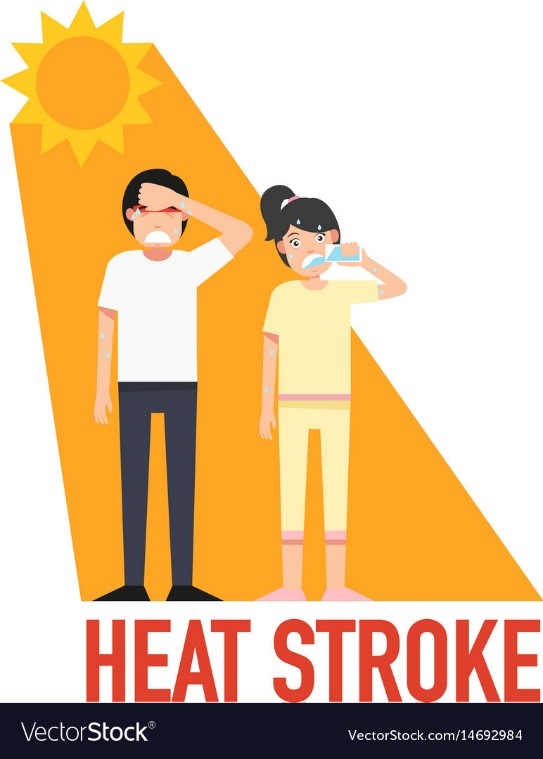Heat exhaustion is a heat-related illness that can occur after you’ve been exposed to high temperatures, and it often is accompanied by dehydration.
There are two types of heat exhaustion:
• Water depletion. Signs include excessive thirst, weakness, headache, and loss of consciousness.
• Salt depletion. Signs include nausea and vomiting, muscle cramps, and dizziness.
Although heat exhaustion isn’t as serious as heat stroke, it isn’t something to be taken lightly. Without proper intervention, heat exhaustion can progress to heat stroke, which can damage the brain and other vital organs, and even cause death.
Symptoms of Heat Exhaustion:
The most common signs and symptoms of heat exhaustion include:
• Confusion
• Dark-colored urine (a sign of dehydration)
• Dizziness
• Fainting
• Fatigue
• Headache
• Muscle or abdominal cramps
• Nausea, vomiting, or diarrhea
• Pale skin
• Profuse sweating
• Rapid heartbeat
Treatment for Heat Exhaustion:
If you, or anyone else, has symptoms of heat exhaustion, it’s essential to immediately get out of the heat and rest, preferably in an air-conditioned room. If you can’t get inside, try to find the nearest cool and shady place.
Other recommended strategies include:
• Drink plenty of fluids, especially sports drinks to replace lost salt (avoid caffeine and alcohol).
• Remove any tight or unnecessary clothing.
• Take a cool shower, bath, or sponge bath.
• Apply other cooling measures such as fans or ice towels.
If such measures fail to provide relief within 15 minutes, seek emergency medical help, because untreated heat exhaustion can progress to heat stroke.
After you’ve recovered from heat exhaustion, you’ll probably be more sensitive to high temperatures during the following week. So it’s best to avoid hot weather and heavy exercise until your doctor tells you that it’s safe to resume your normal activities.
Risk Factors for Heat Exhaustion:
Heat exhaustion is strongly related to the heat index, which is a measurement of how hot you feel when the effects of relative humidity and air temperature are combined. A relative humidity of 60% or more hampers sweat evaporation, which hinders your body’s ability to cool itself.
The risk of heat-related illness dramatically increases when the heat index climbs to 90 degrees or more. So it’s important — especially during heat waves — to pay attention to the reported heat index, and also to remember that the heat index is even higher when you are standing in full sunshine.
Heat Stroke: Symptoms and Treatment:
• Symptoms of Heat Stroke
• First Aid for Heat Stroke
• Risk Factors for Heat Stroke
• Preventing Heat Stroke
• Outlook for Heat Stroke
Heat stroke is the most serious form of heat injury and is considered a medical emergency. If you suspect that someone has heat stroke — also known as sunstroke — call 911 immediately and give first aid until paramedics arrive.
Heat stroke can kill or cause damage to the brain and other internal organs. Although heat stroke mainly affects people over age 50, it also takes a toll on healthy young athletes.
Heat stroke often occurs as a progression from milder heat-related illnesses such as heat cramps, heat syncope (fainting), and heat exhaustion. But it can strike even if you have no previous signs of heat injury.
Heat stroke results from prolonged exposure to high temperatures — usually in combination with dehydration — which leads to failure of the body’s temperature control system. The medical definition of heat stroke is a core body temperature greater than 104 degrees Fahrenheit, with complications involving the central nervous system that occur after exposure to high temperatures. Other common symptoms include nausea, seizures, confusion, disorientation, and sometimes loss of consciousness or coma.
Heat Stroke
Learn the newest thinking about what to do in case of heat stroke.
Symptoms of Heat Stroke:
The hallmark symptom of heat stroke is a core body temperature above 104 degrees Fahrenheit. But fainting may be the first sign.
Other symptoms may include:
• Throbbing headache
• Dizziness and light-headedness
• Lack of sweating despite the heat
• Red, hot, and dry skin
• Muscle weakness or cramps
• Nausea and vomiting
• Rapid heartbeat, which may be either strong or weak
• Rapid, shallow breathing
• Behavioral changes such as confusion, disorientation, or staggering
• Seizures
• Unconsciousness
First Aid for Heat Stroke:
If you suspect that someone has a heat stroke, immediately call 911 or transport the person to a hospital. Any delay seeking medical help can be fatal.
While waiting for the paramedics to arrive, initiate first aid. Move the person to an air-conditioned environment — or at least a cool, shady area — and remove any unnecessary clothing.
If possible, take the person’s core body temperature and initiate first aid to cool it to 101 to 102 degrees Fahrenheit. (If no thermometers are available, don’t hesitate to initiate first aid.)
Try these cooling strategies:
• Fan air over the patient while wetting his or her skin with water from a sponge or garden hose.
• Apply ice packs to the patient’s armpits, groin, neck, and back. Because these areas are rich with blood vessels close to the skin, cooling them may reduce body temperature.
• Immerse the patient in a shower or tub of cool water.
• If the person is young and heathy and suffered heat stroke while exercisingvigorously — what’s known as exertional heat stroke — you can use an ice bath to help cool the body.
Risk Factors for Heat Stroke:
Heat stroke is most likely to affect older people who live in apartments or homes lacking air conditioning or good airflow. Other high-risk groups include people of any age who don’t drink enough water, have chronic diseases, or who drink excessive amounts of alcohol.
Heat stroke is strongly related to the heat index, which is a measurement of how hot you feel when the effects of relative humidity and air temperature are combined. A relative humidity of 60% or more hampers sweat evaporation, which hinders your body’s ability to cool itself.
The risk of heat-related illness dramatically increases when the heat index climbs to 90 degrees or more. So it’s important — especially during heat waves — to pay attention to the reported heat index, and also to remember that exposure to full sunshine can increase the reported heat index by 15 degrees.
If you live in an urban area, you may be especially prone to develop heat stroke during a prolonged heat wave, particularly if there are stagnant atmospheric conditions and poor air quality. In what is known as the “heat island effect,” asphalt and concrete store heat during the day and only gradually release it at night, resulting in higher nighttime temperatures.
Other risk factors associated with heat-related illness include:
Age. Infants and children up to age 4, and adults over age 65, are particularly vulnerable because they adjust to heat more slowly than other people.
Health conditions. These include heart, lung, or kidney disease, obesity or underweight, high blood pressure, diabetes, mental illness, sickle cell trait, alcoholism, sunburn, and any conditions that cause fever.
Medications. These include antihistamines, diet pills, diuretics, sedatives, tranquilizers, stimulants, seizure medications (anticonvulsants), heart and blood pressure medications such as beta-blockers and vasoconstrictors, and medications for psychiatric illnesses such as antidepressants and antipsychotics. Illegal drugs such as cocaine and methamphetamine also are associated with increased risk of heat stroke.
People with diabetes — who are at increased risk of emergency room visits, hospitalization, and death from heat-related illness — may be especially likely to underestimate their risk during heat waves, according to a recent study presented at the Endocrine Society’s annual meeting by researchers from the Mayo Clinic in Arizona, the National Ocean and Atmospheric Administration, and the National Weather Service.
Check with your doctor to see if your health conditions and medications are likely to affect your ability to cope with extreme heat and humidity.
Preventing Heat Stroke:
When the heat index is high, it’s best to stay in an air-conditioned environment. If you must go outdoors, you can prevent heat stroke by taking these steps:
• Wear lightweight, light-colored, loose-fitting clothing, and a wide-brimmed hat.
• Use a sunscreen with a sun protection factor (SPF) of 30 or more.
• Drink extra fluids. To prevent dehydration, it’s generally recommended to drink at least eight glasses of water, fruit juice, or vegetable juice per day. Because heat-related illness also can result from salt depletion, it may be advisable to substitute an electrolyte-rich sports drink for water during periods of extreme heat and humidity.
• Take additional precautions when exercising or working outdoors. The general recommendation is to drink 24 ounces of fluid two hours before exercise, and consider adding another 8 ounces of water or sports drink right before exercise. During exercise, you should consume another 8 ounces of water every 20 minutes, even if you don’t feel thirsty.
• Reschedule or cancel outdoor activity. If possible, shift your time outdoors to the coolest times of the day, either early morning or after sunset.
Other strategies for preventing heat stroke include:
• Monitoring the color of your urine. Darker urine is a sign of dehydration. Be sure to drink enough fluids to maintain very light-colored urine.
• Measuring your weight before and after physical activity. Monitoring lost water weight can help you determine how much fluid you need to drink.
Avoid fluids containing caffeine or alcohol, because both substances can make you lose more fluids and worsen heat-related illness. Also, do not take salt tablets unless your doctor has told you to do so. The easiest and safest way to replace salt and other electrolytes during heat waves is to drink sports beverages or fruit juice.
Check with your doctor before increasing liquid intake if you have epilepsy or heart, kidney, or liver disease; are on fluid-restricted diets; or have a problem with fluid retention.
If you live in an apartment or house without fans or air conditioning, try to spend at least two hours each day — preferably during the hottest part of the day — in an air-conditioned environment. At home, draw your curtains, shades, or blinds during the hottest part of the day, and open windows at night on two sides of your building to create cross-ventilation.
If you’re a senior who either can’t afford to buy or run an air conditioner, check with your local Area Agency on Aging for programs that can assist you. One such program is the Low Income Home Energy Assistance Program (LIHEAP).
Outlook for Heat Stroke:
After you’ve recovered from heat stroke, you’ll probably be more sensitive to high temperatures during the following week. So it’s best to avoid hot weather and heavy exercise until your doctor tells you that it’s safe to resume your normal activities.









